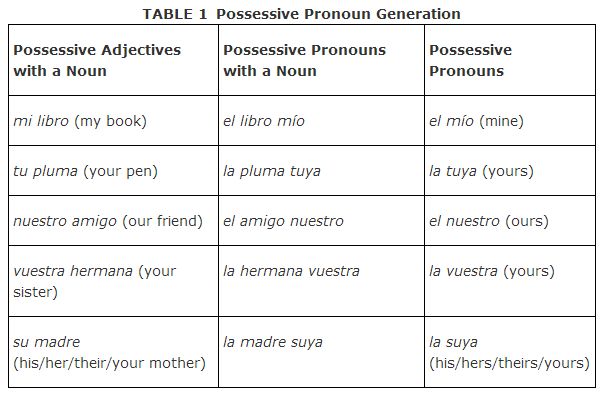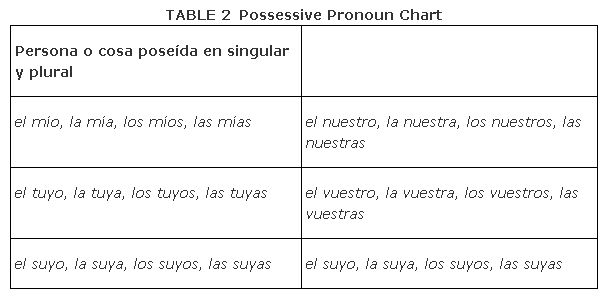Possessive adjectives have two forms. The long form is used with a definite article to make a possessive pronoun. This form is used whenever the noun is being replaced rather than modified.
Possessive pronouns match the gender and number of the noun they replace, not the gender and number of the possessor of the noun. The possessive pronouns are usually listed in a chart similar to a conjugation chart (see Table 1).

The chart below shows how the possessive pronoun is based on the long form of the possessive adjective with a definite article. When there is no stated noun, the long form of the possessive adjective becomes a possessive pronoun. The possessive pronoun and the article that precedes it reflect the gender of the unstated but understood noun that is possessed.
The order of the possessive pronouns in Table 2 reflects the order of the subject pronouns that would refer to the owner. For example, if the owner is yo, the possessive pronoun is either el mío, la mía, los míos, or las mías. The number (plural or singular) of the possessive pronoun matches the noun being owned, not the owner. Once you decide to use the possessive pronoun el suyo, for example, you only make it plural if it is in front of a plural noun. It doesn't matter how many people own the noun.

A common usage of this version of possessive pronoun is after a form of the linking verbs ser or estar. Notice that the English possessive is different when it follows a form of “to be” (“is” or “are”). For example, “ my book” becomes “the book is mine.”
- El libro es mío. (The book is mine.)
- las fotografías bonitas tuyas (your pretty pictures)
- Las fotografias bonitas son tuyas. (The pretty pictures are yours.)
- la casa nuestra (our house)
- La casa es nuestra. (The house is ours.)
- las niñas suyas (his/ her/ their/ your [formal] girls)
- Las niñas son suyas. (The girls are his/ hers/ theirs/ yours.)
|
|
|
|
|
|
|
|
|